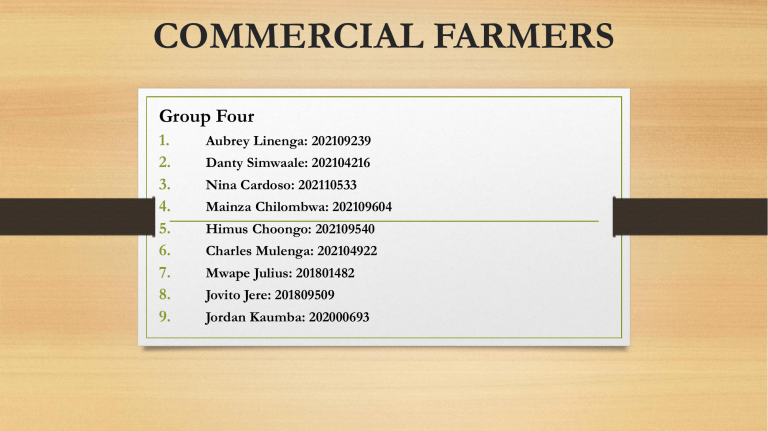
COMMERCIAL FARMERS Group Four 1. 2. 3. 4. 5. 6. 7. 8. 9. Aubrey Linenga: 202109239 Danty Simwaale: 202104216 Nina Cardoso: 202110533 Mainza Chilombwa: 202109604 Himus Choongo: 202109540 Charles Mulenga: 202104922 Mwape Julius: 201801482 Jovito Jere: 201809509 Jordan Kaumba: 202000693 Introduction ◦ Definitions ◦ Characteristics ◦ Commercial Farming ◦ ◦ ◦ ◦ ◦ Types of commercial farmers Merits Demerits Role of commercial farming Strategies farmers can use to promote sustainable farm production Definitions o Farming is the act or process that involves the cultivation of land for planting seeds, growing edible plants, rearing of animals for meet, milk, bee keeping and aquaculture. Or o Farming is the process of producing food, feed and fibre by cultivation of certain plants and the raising of livestock (domesticated animals), http://olc.spsd.sk.ca/de/pd/instr/alpha.html An Overview on Categories of Farmers There are four main categories of farmers in Zambia namely: ◦ Small Scale Farmers: ◦ Normally produce only enough for household consumption and occasional marketable surplus. ◦ Medium Farmers ◦ Produce maize and a few other cash crops for market ◦ Emergent-Commercial Farmers ◦ These are small holders who cultivate between five to twenty hectares of land and usually participating in the market and indent to produce and sell more ◦ Commercial Farmers ◦ These are large scale farmers who produce various crops and livestock for both local and international markets Characteristics of Commercial Farmers These are ◦ Large scale production ◦ Mostly located along the line of rail and connected to the national grid ◦ One type of production in normally in large areas ◦ Capital intensive ◦ Use of high yielding varieties as well as high doses of inputs such fertilizers, insecticide, acaricide etc ◦ Willingness to take risks ◦ Production is intended for both the local and international markets ◦ Heavy machinery and higher human labour ◦ In most cases, it covers extensive pieces of land ◦ Farming is done all year round Types of Commercial Farmers ◦ Dairy Farmers ◦ Grain Farmers ◦ Plantation Farmers ◦ Livestock Ranching Farmers ◦ Mixed Crop and Livestock Farmers ◦ Horticulture Farmer ◦ Floriculture ◦ Aquaculture ◦ Apiculture Merits of Commercial Farmers ◦ Helps in the improvement of local infrastructure: E.g. Roads in the Mkushi Farm block ◦ Job Creation for the locals ◦ With introduction of intensive farming, agro produce have become less expensive and helping in solving the issues of food security ◦ Provision of raw material for agribusiness manufacturing companies ◦ Lowering the cost of production by use of mechanized farming methods, e.g. Combine harvester, boom sprayer etc ◦ Contribution to the GDP – about 19.9% as at 2020 – 2021 reporting period ◦ Large productivity of food is possible on a small land Demerits of Commercial Farmers ◦ High use of inorganic fertilizers, pesticides and insecticides, which lead to environmental degradation ◦ E.g. bee keeping is negatively affected due to chemical infestation ◦ Some of the beneficial micro-organism are affected ◦ Extensive cutting down of trees that leads to destruction of the national rain forest, which in turn leads to unstable rain pattern ◦ Heavy agro mechanization leads to soil degradation ◦ Heavy use of GMOs that have a negative impact on human health ◦ Heavy use of machinery leads to unemployment The Role of Commercial Farmers in Economic Development ◦ Contribution to National Income (GDP) ◦ Source of foreign exchange for the country ◦ Offering employment opportunities for local people ◦ Improving rural welfare ◦ Providing food and raw materials for agro business manufacturing industry ◦ Provision of surplus income ◦ Improving nutrition ◦ Lowering the cost of food ◦ Creation of infrastructure in rural districts ◦ Help to reduce gender inequalities Strategies for Sustainable Farm Production Environmental Sustainability in agriculture means good stewardship of natural systems and resources that farms rely on such as building and maintaining health soils, minimizing pollution and promoting biodiversity. ◦ Promotion of conservation farming methods; such as minimum tillage, promotion of cover crops (planting of sun-hemp to) and avoid burning crop residues ◦ Promotion of precision farming methods such as use of GPS machinery and drones technologies ◦ Crop rotation and promotion of diversification ◦ Applying integrated pest management practices ◦ Integrating livestock and crops, E.g. manure collected from feed lots can be fully decomposed and applied in the field ◦ Adoption of agroforest practices, e.g. planting rows of acacia tree that fixes nitrogen into the soil ◦ Application of lime in the field to balance the PH levels Conclusion References


